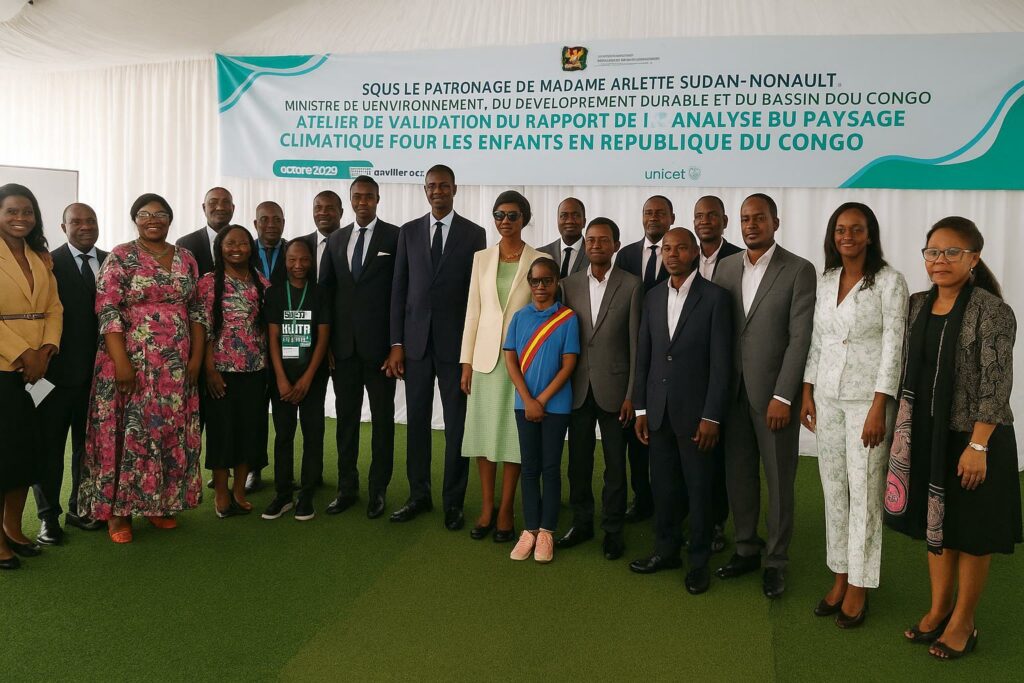A Study That Shifts the Climate Lens to Children
When Environment, Sustainable Development and Congo Basin Minister Arlette Soudan-Nonault inaugurated the validation workshop for the Climate Landscape Analysis for Children, she signalled a political inflection point. The minister emphasised that minors are “disproportionately exposed to floods, heatwaves and ecosystem degradation” (ACI, 11 Oct 2024). The study, elaborated with UNICEF technical support, argues that any effective adaptation strategy must recognise childhood as the most vulnerable and simultaneously the most promising stage of life.
By foregrounding the experience of the young, Brazzaville joins a narrow cohort of African capitals adopting child-centred climate diagnostics. The urgency is palpable: the 2023 flood season displaced thousands of households along the Congo River, affected school calendars and strained paediatric services. In a country where almost 60 percent of the population is under 25, the climate agenda is, by demographic necessity, a youth agenda.
Methodology and Strategic Findings
The 112-page report combines meteorological modelling with socio-economic surveys conducted in Brazzaville, Pointe-Noire and five rural districts. Researchers correlated satellite rainfall data with malnutrition trends and school absenteeism, producing a granular vulnerability index. Four thematic pillars structure the analysis: climate, environment, energy and disasters.
Key findings confirm that recurrent inundations and erosive rainfall events interrupt schooling for an average of 18 days per year in riverine communes. Conversely, regions facing prolonged dry spells report decreased agricultural yields, intensifying child food insecurity. While these conclusions may appear intuitive, their quantification equips planners with evidence to recalibrate resource allocation, from climate-proof classrooms to early-warning digital platforms.
Financial and Legal Levers for Implementation
Minister Soudan-Nonault reminded participants that a technical committee, established on 19 July 2024, will steer the integration of the study’s priorities into both national budgets and partner portfolios. Legally, the analysis dovetails with Congo’s commitments under the Paris Agreement and the African Charter on the Rights and Welfare of the Child, providing a solid jurisprudential basis for future decrees.
From a budgetary perspective, the report recommends channeling at least 20 percent of forthcoming climate-adaptation funds toward child-specific measures, such as resilient school infrastructure and paediatric health surveillance. International partners have responded favourably: the African Development Bank’s regional office indicated that concessional financing windows could align with the study’s costed action plan, once formally adopted.
Voices of Partners and Youth
UNICEF’s Deputy Representative, Dr James Mugaji, told the workshop that an “inclusive, participatory momentum” is indispensable for implementation. He underscored that only a multi-stakeholder coalition spanning government, civil society, the private sector and youth groups can convert recommendations into tangible safeguards.
Several adolescents, invited as observers, articulated their concerns with poise. Fourteen-year-old Félicité Mabiala, a member of a Brazzaville eco-club, noted that “youth often understand the local micro-climates better than adults because we walk the same flood-prone roads to school every day.” Such testimonies enrich policy debate and reinforce the study’s call for participatory climate governance.
The Point Eco-Legal: From Study to Statute
In the medium term, success will hinge on embedding child-sensitive adaptation clauses in sectoral laws, notably the Forestry Code and the forthcoming Disaster Risk Management Bill. Legal scholars at Marien-Ngouabi University contend that explicit references to children’s rights within environmental statutes would strengthen litigation tools in instances of climate-related harm.
Economically, integrating the study’s recommendations is projected to unlock co-benefits: healthier children translate into higher educational attainment, fortifying the human-capital base essential for Congo’s ambition to diversify beyond hydrocarbons.
Outlook for a Child-Centred Green Transition
The workshop closed on a cautiously optimistic note. Experts agreed to finalise a results framework within ninety days, while ministries refine sectoral annexes. In the interim, pilot projects—solar-powered boreholes in drought-affected districts, flood-resilient classrooms along the Sangha River—are expected to demonstrate proof of concept.
Congo-Brazzaville has long presented itself as a custodian of the Congo Basin rainforest, often referred to as the planet’s “second lung”. By aligning that ecological narrative with an explicit pledge to safeguard its youngest citizens, the government sets the stage for a more inclusive form of environmental stewardship. In Dr Mugaji’s words, “the ultimate goal is not merely to shield children from climate shocks, but to empower them as agents of the low-carbon transition.”

